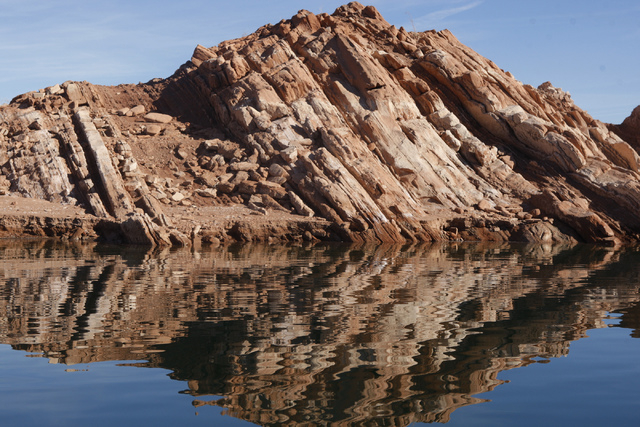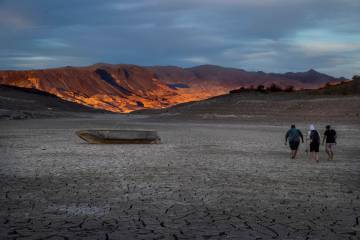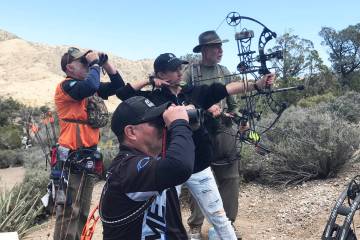Great day on the water
Spend enough time in the outdoors and sooner or later you will witness something you have never seen or heard before. Obviously, what that something will be is unique to each one of us and dependent on our individual experiences.
It might be the bugle of a mature bull elk rising from a mist-covered stand of timber, the glimpse of a mountain lion running across a rural highway or the coordinated flight of a pair of golden eagles hunting down a young mule deer. These are three of my favorite outdoor experiences, and each one holds a special place among my memories. Now it may be time to make a little more room on the outdoor memory shelf.
Early Monday morning, my friend Roger and I were netting live shad in what is left of Vegas Bay. Well, Roger was netting shad while I got sidetracked with the beauty of the morning, the unusually loud chatter of the birds, and the strange behavior exhibited by the grebes hanging out nearby. Though I spent several years working on Lake Mead, and have caught my share of fish from its waters, the birds’ behavior was something I had never seen before. Or perhaps I just never took the time to see it.
At first I thought the birds were simply playing around, but it soon became apparent that they were involved in something much more. Like participants in a carefully choreographed dance, a pair of grebes would come together and spend time mirroring each other’s actions. Then they faced each other, flattened their crest so it resembled a furrowed brow, dropped their heads and extended their necks while chattering at one another. They came close together and then all of a sudden they puffed their checks so their face appeared rounded. Then they both seemed to jump from the water and literally ran side by side across its glassy surface with their wings held open. After 25 yards or so they both dived under water at the same time.
After seeing this repeat with different pairs of birds, I came to realize that we were witnessing a courting ritual, not unlike that of sage grouse, wild turkeys or even bighorn sheep. The dance was so intriguing that in some ways I was sad to leave when Roger’s hard work was done and there were enough shad in the bait tank to go fishing.
From Vegas Bay we motored our way past several boats whose passengers seemed to be doing a lot more fishing than catching. “Not a good sign,” I thought.
We made our way to a cove between Saddle Island and Sand Island. There we baited up with the live shad and drifted them near the bottom while working a variety of lures along the shoreline. We both were hoping to include a smallmouth bass or two in our catch.
In an unusual twist of fate, my fishing rod was the first to bend over hard when what turned out to be a small striped bass tried to swallow my bait. He was only about 12 or 13 inches long, but I was pleased to see that he was well fed. Usually it is Roger who catches the first fish. During the next couple of hours Roger and I caught and released another five striped bass. There was nothing huge in the mix, but we weren’t skunked either.
I was using a drop shot configuration with a single hook. Roger tied his hook at the end of his line with a large split shot about two feet above the hook. Both setups caught fish, but even though Roger’s caught more than mine, I think the only way to determine which setup is better is to do some more fishing, I mean testing.
About mid-morning we reeled in and made our way across smooth water toward Callville Bay and began working some coves in the hope of catching a few black bass. As we worked the shoreline with lures, we did so under the watchful eye of a bald eagle perched high on the hill above us. Though we were casting lures, we also kept a line in the water that was baited up with a live shad. It was the shad on Roger’s line that finally caught the attention of pretty smallmouth bass, but that was the only one we caught that morning.
Though the fishing action was a little on the slow side, all in all it was a great day on the water. We rode across glass-smooth water, caught fish, saw a bald eagle and to top it all off we witnessed the unique courting ritual of the western grebe. With that experience safely on the memory shelf, I can’t wait to find out what awaits me on my next trip out and about.
Freelance writer Doug Nielsen is a conservation educator for the Nevada Department of Wildlife. His “In the Outdoors” column, published Thursday in the Las Vegas Review-Journal, is not affiliated with or endorsed by the NDOW. Any opinions he states in his column are his own. He can be reached at intheoutdoorslv@gmail.com.























